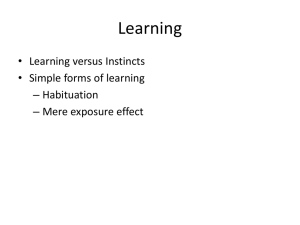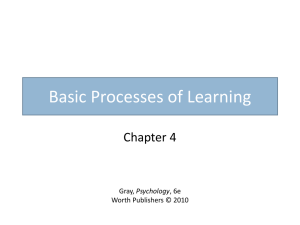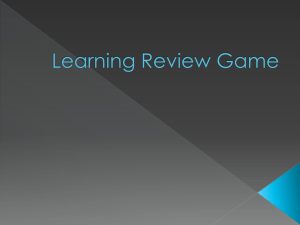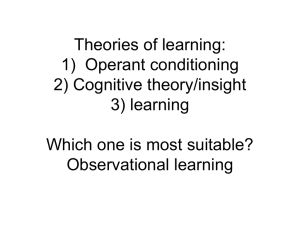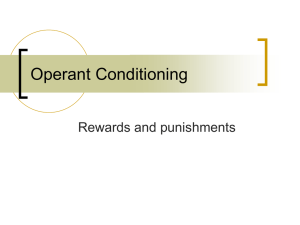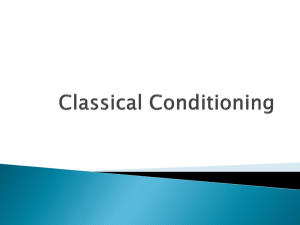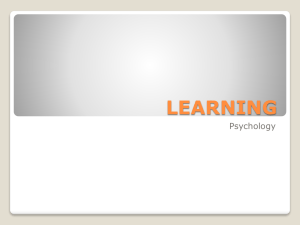Learning Unit VI
advertisement
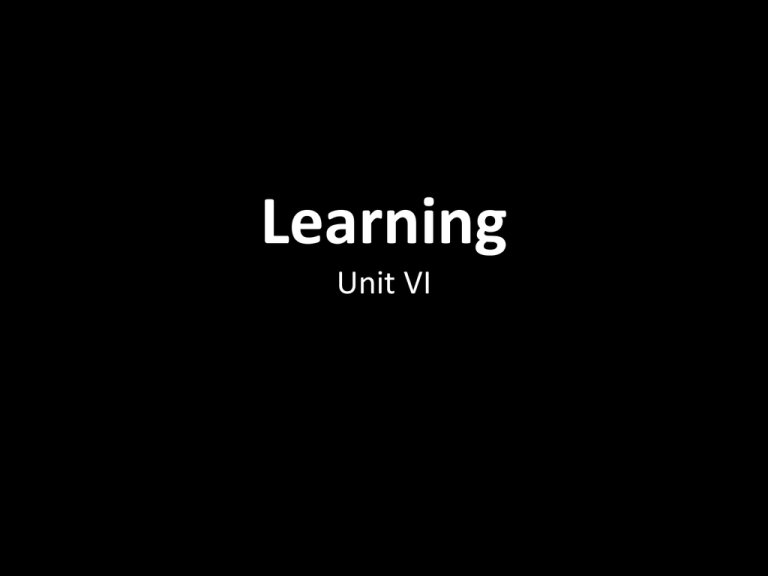
Learning Unit VI How do we learn? • Learning- the process of acquiring new and relatively enduring information or behaviors • By learning, we are able to adapt to our environments • John Locke agreed with the ideas of Aristotle and said that we learn by association • This means that our minds naturally connect events that occur in sequence * How do we learn? • An example of learning by association: – You see and smell freshly baked bread, eat some, and find it satisfying. The next time you see and smell fresh bread, you will expect that eating it will again be satisfying – Give some one a red pen and ask them to correct someone’s essay, they will find more errors than if you had given them a black pen * How do we learn? • Habituation- an organism’s decreasing response to a stimulus with repeated exposure to it – A dog and a dog whistle • Associative learning- learning that certain events occur together – The events may be two stimuli or a response and its consequences – The process of learning associations is called conditioning * How do we learn? • In classical conditioning we learn to associate two stimuli and thus to anticipate events – We learn that a flash of lightning signals an impending crack of thunder so when lightning strikes we begin to brace ourselves • Stimulus- any event or situation that evokes a response • In operant conditioning we learn to associate a response and its consequence – We learn to repeat acts followed by good results and avoid acts followed by bad results * How do we learn? • Cognitive learning- the acquisition of mental information, whether by observing events, by watching others, or through language – Observational learning is one form of cognitive learning • it lets us learn from others’ experiences * Classical Conditioning • Ivan Pavlov’s studies on classical conditioning are considered to be one of if not the most famous psychological research experiments in history • Classical conditioning- a type of learning in which one learns to link two or more stimuli and anticipate events • Pavlov’s work laid the foundation for much of John B. Watson’s work * Classical Conditioning • Watson urged his colleagues to discard reference to inner thoughts, feelings, and motives • Watson believed the goal of psychology was to predict and control behavior • Introspection was worthless according to Watson • Watson believed psychology should be an objective science based on observable behaviors * Classical Conditioning • Watson’s ideas became known as behaviorism – Behaviorism- the view that psychology should be an objective science and that psychology should study behavior without reference to mental processes – Most psychologists today agree with part one of behaviorism but not part two • Watson and Pavlov believed that the basic laws of learning were the same for all animals * Classical Conditioning Pavlov’s experiment • Pavlov was a doctor that first studied the digestive system • Pavlov’s turned towards learning accidently • When conducting his digestive system studies he realized that the dogs would salivate without fail each time food was put in their mouth • He then realized that the dog would even start to salivate at the mere sight of the food, at the sight of the food dish, or even at the sound of a person’s footsteps • He started to realize that this salivation was showing a form of learning * Classical Conditioning Pavlov’s experiment • Pavlov started to experiment on why the dog started to salivate even before they saw the food • To eliminate extraneous variables they isolated the dog in a small room, secured it in a harness, and attached a device to divert its saliva to a measuring instrument * Classical Conditioning Pavlov’s Experiment • From the next room, they presented food to the dog • They then paired various neutral stimuli with food in the dog’s mouth – A stimulus that elicits no response before conditioning – Events the dog could see or hear but didn’t associate them with food • What they wanted to find out was if a sound or sight was regularly signaled with the arrival of food, would the dog learn the link between the two * Classical Conditioning Pavlov’s experiment • If the dog did learn the link between the two, would they salivate anticipating food • They found the answer to both questions to be yes • Just before placing food in the dog’s mouth to produce salivation, Pavlov sounded a tone • After a few times of pairing the tone with the presentation of food, the dog began to salivating to the tone alone * Classical Conditioning Pavlov’s experiment • Pavlov later found that a pairing with a buzzer, a light, a touch on the leg, and the sight of a circle all led to the dog salivating anticipating food • A dog does not learn to salivate in response to food in its mouth • Food in the mouth automatically, unconditionally, triggers a dog’s salivary reflex * Classical Conditioning Pavlov’s experiment • Pavlov called the natural drooling an unconditioned response(UR) – Unconditioned response- an unlearned, naturally occurring response to an unconditioned stimulus • The food was an unconditioned stimulus – A stimulus that unconditionally- naturally and automatically- triggers a response(US) * Classical Conditioning Pavlov’s experiment • Salivation in response to the tone is learned so it is called a conditioned response(CR) – A learned response to a previously neutral stimulus – The response is conditioned upon the dog’s associating the tone and the food • The stimulus that used to be neutral like the tone becomes the conditioned stimulus(CS) – An originally irrelevant stimulus that after association with an unconditioned stimulus comes to trigger a conditioned response * Classical Conditioning Pavlov’s experiment • Conditioned=learned • Unconditioned=unlearned • Try the example of the tone and a puff of air in your eye – Identify the NS, US, UR, CS, CR • Pavlov would spend the next three decades looking into his conditioning studies even further * Classical Conditioning • Acquisition- in classical conditioning, the initial stage, when one links a neutral stimulus and an unconditioned stimulus so that the neutral stimulus begins triggering the conditioned response • What happens if the US appeared before the NS? – Conditioning usually does not happen when the NS follows the US * Classical Conditioning • Higher-order conditioning- a procedure in which the conditioned stimulus in one conditioning experience is paired with a new neutral stimulus, creating a second conditioned stimulus – Example: an animal that has learned that a tone predicts food might then learn that a light predicts the tone and being responding to the light alone * Classical Conditioning • Higher-order conditioning is often called second order conditioning • High-order conditioning tends to be weaker than first-order conditioning * Classical Conditioning • What happens if after conditioning, the CS occurred repeatedly without the US? • If the tone sounded again and again but no food appeared what would happen? • The dogs would start to salivate less and less • Extinction- the diminishing of a conditioned response; occurs in classical conditioning when an unconditioned stimulus does not follow a conditioned stimulus * Classical Conditioning • Spontaneous recovery- the reappearance, after a pause, of an extinguished conditioned response • This made Pavlov think that extinction was suppressing the CR rather than eliminating it * Classical Conditioning • Pavlov noticed that a dog conditioned to the sound of one tone also responded somewhat to the sound of a new and different tone • Generalization- the tendency, once a response has been conditioned, for stimuli similar to the conditioned stimulus to elicit similar responses * Classical Conditioning • Generalization can be adaptive • Toddlers taught to fear moving cars can also become afraid of moving trucks and motorcycles • Generalized fears can linger for awhile • We tend to like unfamiliar people more if they look some what like someone we’ve learned to like rather than dislike Classical Conditioning • Discrimination- the learned ability to distinguish between a conditioned stimulus and stimuli that do not signal an unconditioned stimulus • In Pavlov’s experiment, the dogs learned to salivate to a particular tone and not to other tones • Being able to recognize these differences is adaptive • Confronted by a guard dog, your response may be different than when you confronted by a guide dog * Classical Conditioning • Most psychologists today agree that classical conditioning is a basic form of learning • According to current psychologists, Pavlov’s ideas were incomplete, because modern psychology is a combination of biology, psychology, and cultural environment • The main thing learned from his studies is that classical conditioning is one way that virtually all organisms learn to adapt to their environment * Classical Conditioning • Pavlov also showed us how learning can be studied objectively • Pavlov’s work involved very little if any subjective judgments or guesses about what went on in a dog’s mind • Pavlov presented a way to study psychology scientifically * Classical Conditioning • Pavlov’s work provided a basis for Watson’s idea that human emotions and behaviors are mainly a bundle of conditioned responses • Watson’s Little Albert experiment is an example of classical conditioning * Operant conditioning • Classical conditioning and operant conditioning are both examples of associate learning but they are very different • Classical conditioning forms associations between stimuli and it involves respondent behavior – Actions that are automatic responses to a stimulus • Operant conditioning- a type of learning in which behavior is strengthened if followed by a reinforcer or diminished if followed by a punisher * Operant conditioning • In operant conditioning actions followed by reinforcers increase; those followed by punishers often decrease • Behavior that operates on the environment to produce rewarding or punishing stimuli is called operant behavior * Operant conditioning Skinner’s experiments • BF Skinner would become behaviorism’s most influential and controversial figure • Skinner’s work elaborated on what psychologist Edward L. Thorndike called the law of effect – Behaviors followed by favorable consequences become more likely, and that behaviors followed by unfavorable consequences become less likely • Skinner would use Thorndike’s ideas as a starting point Operant conditioning Skinner’s experiments • Skinner would develop a behavioral technology that revealed principles of behavior control • For his studies, he designed the operant chamber – A chamber containing a bar or key hat an animal can manipulate to obtain a food or water reinforcer – Attached devices record the animal’s rate of bar pressing or key pecking – Also called the Skinner Box * Operant conditioning Skinner’s experiments • The skinner box allowed Skinner to study his idea of reinforcement • Reinforcement- any event that strengthens the behavior it follows • What is reinforcing depends on the animal and the conditions • For people, it could be praise, attention, or a paycheck • For rats it could be food or water * Operant conditioning Skinner’s experiments • Shaping- an operant conditioning procedure in which reinforcers guide behavior toward closer and closer approximations of the desired behavior • Shaping works on building on natural behaviors • With the rat, you would give food to the rat once it starts toward the bar, then only give it to the rat when it gets even closer, and lastly only give the rat the food once it touches the bar * Operant conditioning Skinner’s experiments • In shaping you are hoping for successive approximations – You reward responses that are ever closer to the final desired behavior, and you ignore all other responses • By making rewards contingent on desired behaviors, researchers and animal trainers gradually shape complex behaviors * Operant conditioning Skinner’s experiments • Discriminative stimulus- a stimulus that elicits a response after association with reinforcement • Example: when experimenters reinforced pigeons for pecking after seeing a human face, but not after seeing other images, the pigeon’s behavior showed that it could recognize human faces. The human face was a discriminative stimulus. * Operant conditioning Types of Reinforcers • Positive reinforcement- increasing behaviors by presenting positive reinforcers – Any stimulus that, when presented after a response, strengthens the response • Negative reinforcement- increasing behaviors by stopping or reducing negative stimuli – Any stimulus that, when removed after a response, strengthens the response – Negative reinforcement is not punishment * Operant conditioning Types of Reinforcers • Negative reinforcement can be a reason why drug users go back to using after they have tried stopping. Why? • Negative reinforcement is something that provides relief • Just remember, reinforcement is something that strengthens a certain behavior * Operant conditioning Types of Reinforcers • Primary reinforcer- an innately reinforcing stimulus, such as one that satisfies a biological need – food • Conditioned reinforcer(Secondary reinforcer)- a stimulus that gains its reinforcing power through its association with a primary reinforcer – In the Skinner Box, if a rat figures out that a light signals food coming, they will work to turn the light on – Money, good grades * Operant conditioning Types of Reinforcers • When rewarding behavior you have to be careful to only present the reward after the desired behavior • For the rat, do not present the reward immediately following the rat scratching, sniffing, or just moving around • What happens if there is a delay for the presentation of the reward after the desire behavior is performed? * Operant conditioning Types of Reinforcers • For the rat, if the delay lasts more than 30 seconds, they will not link the reward with the desired behavior • Humans do respond to delayed reinforcers • Paychecks at the end of the week, the good grade at the end of the term, the trophy at the end of the season • Often times small but immediate consequences are sometimes more attractive than big but delayed consequences * Operant conditioning Types of reinforcement schedules • Reinforcement schedules- a pattern that defines how often a desired response will be reinforced • Continuous reinforcement- reinforcing the desired response every time it occurs – Learning occurs rapidly, which makes this the best choice for mastering a behavior – Extinction occurs rapidly – When reinforcement stops, the desired behavior stops soon as well – Real life rarely provides continuous reinforcement * Operant conditioning Types of reinforcement schedules • Partial (intermittent) reinforcementreinforcing a response only part of the time – Slower acquisition of a response but much greater resistance to extinction • Types of reinforcement schedules – Fixed-ratio – Variable-ratio – Fixed-interval – Variable-interval * Operant conditioning Types of reinforcement schedules • Fixed ratio schedule- a reinforcement schedule that reinforces a response only after a specified number of responses – Free drink after 10 purchases – Once conditioned, animals will pause only briefly after a reinforcer before returning to a high rate of responding * Operant conditioning Types of reinforcement schedules • Variable-ratio- a reinforcement schedule that reinforces a response after an unpredictable number of responses – Slot machines, fishing, and playing golf – These conditioned behaviors are hard to extinguish – Reinforcers increase as the number of responses increase, producing high rates of responding * Operant conditioning Types of reinforcement schedules • Fixed-interval- a reinforcement schedule that reinforces a response only after a specified time has elapsed – Animals on this type of schedule tend to respond more frequently as the anticipated time for reward draws near – Checking the mail – This produces a choppy stop-start pattern rather than a steady rate of response * Operant conditioning Types of reinforcement schedules • Variable-interval- a reinforcement schedule that reinforces a response at unpredictable time intervals – Produce slow, steady responding – Rechecking email or facebook – It is unknown when the waiting will end * Operant conditioning Types of reinforcement schedules • Response rates are usually higher when reinforcement is linked to the number of responses(ratio) rather than to time (interval) • Responding is more consistent when reinforcement is unpredictable (variable) than when it is predictable (fixed) • Skinner believed the reinforcement principles were universal for all animals * Operant conditioning Punishment • Punishment- an event that tends to decrease the behavior that it follows • Swift and sure punishers can powerfully restrain unwanted behavior • A child who is burned by touching a hot stove will learn not to repeat those behaviors • Criminal behavior is influenced by swift and sure punishers than by the threat of severe sentences * Operant conditioning Punishment • Punished behavior is suppressed not forgotten. This suppression of the behavior may negatively reinforce parents’ punishing behavior • Punishing teaches discrimination among situations – Just don’t swear around the house • Punishment can teach fear * Operant conditioning Punishment • Physical punishment may increase aggression by modeling aggression as a way to cope with problems • Punishment tells you what not to do, reinforcement tells you what to do * Operant conditioning Skinner’s Legacy • Skinner repeatedly how he thought external influences not internal thoughts and feelings shape behavior • Skinner encouraged people to use operant principles to influence the behavior of others at work, school, and home • Skinner’s critics said that he dehumanized people by neglecting their personal freedom and by seeking to control their actions * Operant conditioning Skinner’s Legacy • Skinner said that he was using operant conditioning to better people’s lives • He stated that using reinforcers would be more humane than using punishment * Biofeedback • Biofeedback- a system for electronically recording, amplifying, and feeding back information regarding subtle physiological state, such as blood pressure or muscle tension • Helps in training people to counteract harmful things like stress • It allows people to learn techniques of controlling a particular physiological response • Further research found the early results of biofeedback to be overblown and oversold – It does work in tension headaches * Contrasting Classical and Operant Conditioning • Both are associative learning • Both involve acquisition, extinction, spontaneous recovery, generalization, and discrimination • Classical conditioning involves an association of two stimuli we do not control, and we respond automatically(respondent behaviors) • Operant conditioning we associate our own behaviors that act on our environment to produce rewarding or punishing stimuli(operant behaviors) * Cognitive influences on conditioning • Watson and Pavlov underestimated the importance of biological constraints on an organism’s capacity to learn and the effects of cognitive processes • Early behaviorists believed animals could be reduced to mindless mechanisms responding to rewards or punishment with not thinking • Later studies found that animals could learn to expect a certain event – The more predictable the association, the stronger the conditioned response * Cognitive influences on conditioning • Cognitive map- a mental representation of the layout of one’s environment – Rats exploring a map, given no obvious reward will do this – After exploring a maze, rats act as if they have learned a cognitive map of it – The learning is usually not displayed until food is placed in the maze’s goal box – Most of the rats completed the task as quickly as those that had learned the maze through reinforcement * Cognitive influences on conditioning • Latent learning- learning that occurs but is not apparent until there is an incentive to demonstrate it • The point you need to remember with latent learning and cognitive maps is that there is more to learning than associating a response with a consequence; there is also cognition * Cognitive influences on conditioning • Some learning occurs after little or no systematic interaction with our environment • We may puzzle over a problem, and suddenly, the pieces fall together as we perceive the solution in a sudden flash of insight – A sudden realization of a problem’s solution * Cognitive influences on conditioning • Promising people a reward for a task they already enjoy can backfire • Excessive rewards can destroy intrinsic motivation – A desire to perform a behavior effectively for its own sake • Overjustification- the overuse of bribes leading people to see their actions as externally controlled rather than internally appealing * Cognitive influences on conditioning • Extrinsic motivation- a desire to perform a behavior to receive promised rewards or avoid threatened punishment • Rewards used to signal a job well done instead of ones that are meant to bribe or control someone are more effective • These kind of rewards can help boost intrinsic motivation * Learning and personal control • Problems in life are unavoidable • We have to learn how to cope with these problems – Coping- alleviating stress using emotional, cognitive, or behavioral methods • These problems are called stressors • Some of them we deal with directly with problem-focused coping – Attempting to alleviate stress directly- by changing the stressor or the way we interact with that stressor * Learning and personal control • If we have a family fight, we may go directly to that family member to work things out • We tend to use problem-focused strategies when we feel a sense of control over a situation and think we can change the circumstances, or at least change ourselves to deal with the circumstances more capably * Learning and personal control • Emotion-focused coping- attempting to alleviate stress by avoiding or ignoring a stressor and attending to emotional needs related to one’s stress reaction • We turn to this form of coping when we cannot or believe we cannot change a situation • If we cannot get along with the family member, we may search for stress relief by reaching out to friends for support and comfort * Learning and personal control • Emotion-focused coping can be adaptive • We exercise or keep busy with hobbies to avoid thinking about an old addiction • It can also be maladaptive as when students go out and party to cope with stress from needing to read for class * Learning and personal control • Often times, we are presented with stressors that we seem to not be able to get past or cope with • Feeling helpless and oppressed may lead to a state of passive resignation called learned helplessness – The hopelessness and passive resignation an animal or human learns when unable to avoid repeated aversive events * Learning and personal control • Martin Seligman discovered the idea of learned helplessness by studying dogs • The dogs were strapped in a harness and given repeated shocks, with no opportunity to avoid them • Later, when placed in another situation where they could escape the punishment by simply leaping a hurdle, the dogs cowered as if without hope • Animals able to escape the first shocks learned personal control and easily escaped the shocks in the new situation * Learning and personal control • Humans who are faced with repeated traumatic events over which they have no control, may start to feel helpless, hopeless, and depressed • Perceiving a loss of control, we become more vulnerable to stress and ill health • Elderly placed in a nursing home have been found to decline faster and died sooner if they perceived they have no control over their activities * Learning and personal control • Increasing self control noticeably improves health and morale • Losing control provokes an outpouring of stress hormones • Captive animals experience more stress and are more vulnerable to disease than are wild animals * Learning and personal control • Hundreds of studies have compared people who differ in their perceptions of control • On one side are those that have an external locus of control – The perception that chance or outside forces beyond our personal control determine our fate • On the other side are those that have an internal locus of control – The perception that you control your own fate * Learning and personal control • Internals have achieved more in school and work, acted more independently, enjoyed better health, and felt less depressed that did externals • Internals are better at delaying gratification and coping with various stressors • Studies have shown that people that believe in free will, or that willpower is controllable, learn better, perform better at work, and are more helpful * Learning and personal control • Self-control- the ability to control impulses and delay short-term gratification for greater long-term rewards • This ability has predicted good adjustment, better grades, and social success • Using self-control will usually deplete the mental energy needed for self-control but with rest it will recover * Learning by observation • Observational learning- learning by observing others- also called social learning • This usually happens in higher animals, especially humans, because it involves learning without direct experience • By watching someone burn their hand on a hot stove, we are able to learn to not touch the stove * Learning by observation • We learn our native languages and various other specific behaviors by observing and imitating others • this process is called modeling – The process of observing and imitating a specific behavior • Albert Bandura was the pioneering researcher for observational learning * Learning by observation • Bandura’s Bobo the Clown experiment studies observational learning • Bandura determined from his studies that we experience vicarious reinforcement or vicarious punishment, and we learn to anticipate a behavior’s consequences in situations like those we are observing • We are more likely to learn from people we perceive to be similar to ourselves * Learning by observation • Mirror neurons- frontal lobe neurons that some scientists believe fire when performing certain actions or when observing another doing so • The brain’s mirroring of another’s action may enable imitation and empathy • Studies have found that neurons fire when a monkey grasps, holds, or tears something and that the same neurons fire when the monkey watches someone else doing so • When one monkey sees, its neurons mirror what another monkey does * Learning by observation • Prosocial behavior- positive, constructive, helpful behavior • This is the opposite of antisocial behavior • Many business organizations effectively use behavior modeling to help new employees learn communications, sales, and customer service skills • Models are most effective when they are consistent * Extra terms or ideas to know • Interval schedules are more resistant to extinction than ratio • Variable schedules are more resistant to extinction than fixed • Ration schedules produce the highest rates of response • Desensitization- the diminished emotional responsiveness to a negative or aversive stimulus after repeated exposure to it • Tokens-using plastic poker chips or similar tokens instead of money * Extra terms or ideas to know • Vicarious- It refers to the process of learning behaviors through observation of reward and punishment, rather than through direct experience. For example, children who have grown up with older brothers and sisters often learn about behavior and expectations through watching their siblings. When they see their sibling get rewarded for a certain action, they learn that they should also do the behavior. *


